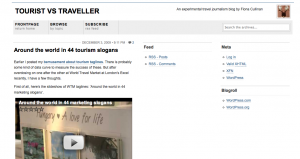It's been two years since I started my first travel blog, What To Wear Where, in an effort to answer the niche packing question: 'What do you wear in trendy Reykjavik in below-freezing December?' While I still think the idea of packing help for any destination/event still has legs, and the blog still brings in a fairly steady stream of traffic, without a community to fuel the ideas, What To Wear Where sort of got stuck in the doldrums.
So I'm going back to basics. I've set up a new blog as a playground for my travel journalism. It's called Tourist Vs Traveller (not for any deep and meaningful reason but because it was free) and you'll find it at http://touristvstraveller.wordpress.com/.

Crowdsourced and client-led content
The first experiment is that I hope the content will be led by others – and my opening post is asking for your input. I'm soliciting views about what kind of content to publish because I don't want the content solely to be defined by me as a journalist. It could be anything, I am open to suggestions. What I do want to do, though, is use it as a place to experiment with lots of lovely Web tools. With a background in digital client publishing, I'm also interested in travel companies who want me to create online content for their offering – not marketing fluff, but the real stories behind the PR, the kind of content that DOES help people decide to buy your product – or not! Y'know, useful stuff.
The problem with travel writing
So what travel writing is out there right now? On the Web, we have trip blogs, review sites and an avalanche of whinging UGC that is rapidly becoming meaningless as a way to make buying decisions. There are also some nice up and coming blogs from travel journalists and bloggers – I'll be adding them to the blog roll as time goes by. In print, we have standard travel narratives and a limited number of news items published by newspapers and magazines and written by a rather exclusive club of commissioned travel journalists (or staff writers on a freebie). And on TV, we have an increasing amount of celebrities and comedians being sent off around the globe in the name of entertainment.
What is harder to find is a middle-ground between Jo Bloggs naming and shaming their hotel and the angled/subjective narrative of the commissioned travel writer/presenter.
Finding fresh ways to tell the story
Where I do find decent content, I'll be linking to it though. I suspect that, for now and for a while, it will be possible to aggregate good examples of experimental travel journalism.
But I think there is also room for journalistic content that goes behind the scenes of a travel product, that tells stories that the newspaper doesn't have room for, or that revisits classic stories from new angles using audio, video, slideshows, aggregated content and social media. It would be great to break out from the form – after all, traditional travel writing is itself rather stuck in the doldrums, in style and structure, in privileged points of view, and because collapsing print budgets mean fewer outlets and options for travel journalists
And I think that the travel industry could potentially pay for this content now that their outlets for print editorial are shrinking – to explain, here's my earlier posting on a potential new business model for travel journalists.
So that's it for now. Please visit the blog and post your comments. I've got the first couple of posts up – all about the nonsense of tourism slogans inspired by two days spent at the World Travel Market (WTM) in November.
And especially for Brummies, there's a winning marketing slogan from St Johns Hotel, Solihull at the end of Around the world in 44 tourism slogans.
